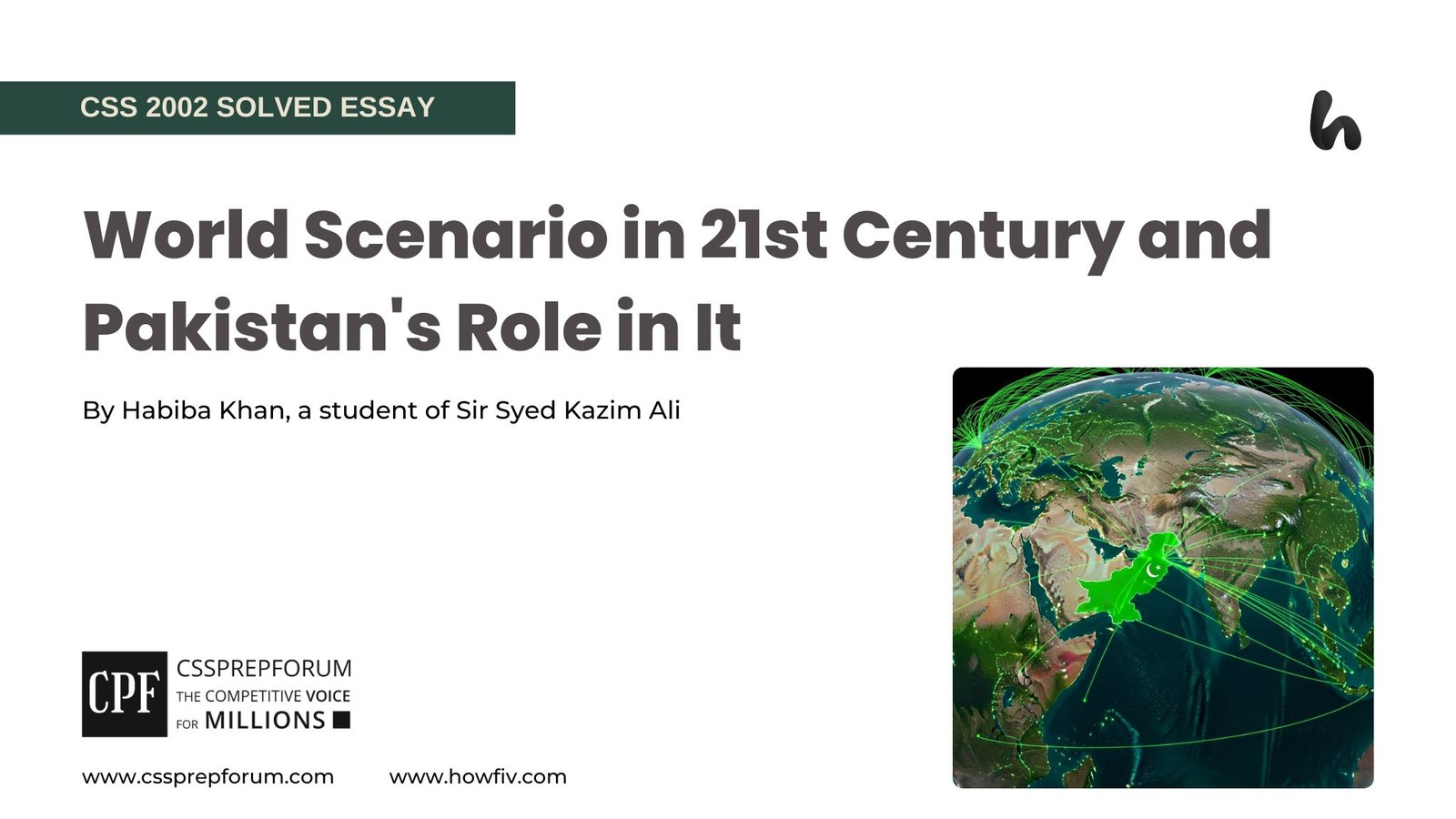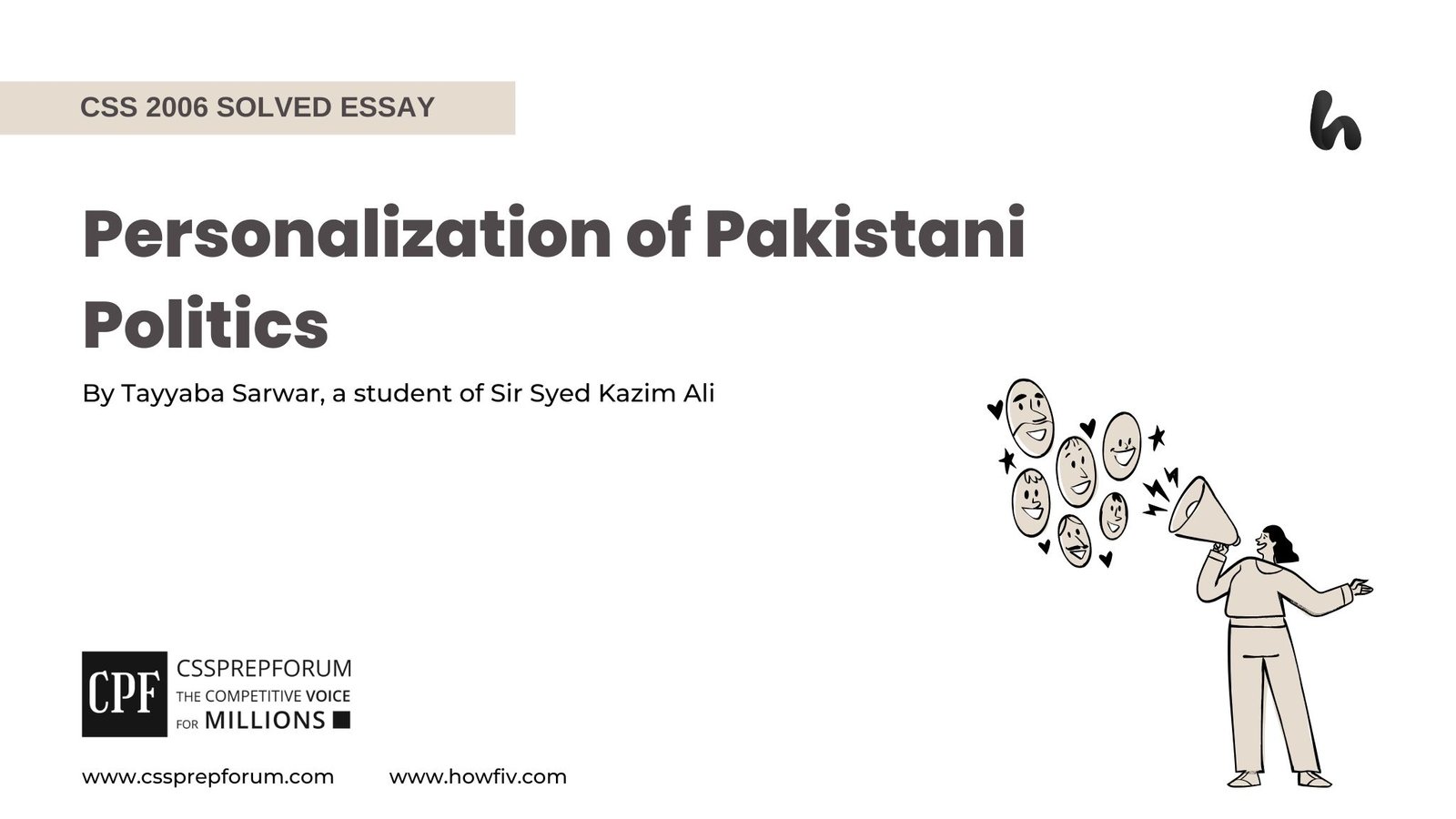PMS 2021 Solved Essay | The Future of Artificial Intelligence
Syed Muhammad Hamza, a Sir Syed Kazim Ali student, has attempted the PMS 2021 Solved Essay “The Future of Artificial Intelligence“ on the given pattern, which Sir Syed Kazim Ali teaches his students. Sir Syed Kazim Ali has been Pakistan’s top English writing and CSS, PMS essay and precis coach with the highest success rate of his students. The essay is uploaded to help other competitive aspirants learn and practice essay writing techniques and patterns to qualify for the essay paper.

Outline
1-Introduction
While artificial intelligence poses some challenges of data scarcity, privacy breaches, and skill deficiencies, particularly in developing nations, it continues to revolutionize various sectors by enhancing efficiency and enabling advanced applications, thereby having immense potential to revolutionize multiple sectors, from healthcare to security.
2-Overview of the Current Status of Artificial Intelligence
- ✓ Assisting in navigation
- Case-in-point: Artificial intelligence is used by several logistics companies, like Careem and Uber, for navigation purposes.
- ✓ Helping in increasing productivity
- Case–in–point: Marketing firms now have AI – as gospel magic – to create attention-grabbing advertisements or launch successful marketing campaigns within no time.
- ✓ Powering robotics
- Case-in-point: The robotic surgeries in the health care system with high precision and accuracy are all due to the intelligence inculcated in the robots.
- ✓ Incorporating in lifestyle
- Case–in–point: The introduction of self–driving vehicles and facial recognition features in electronic devices has now become a part of society.
3-What would the future of Artificial Intelligence be in different domains of society?
- ✓ Healthcare
- Case–in–point: Mayo Clinic is developing the AI-powered model to predict whether a pregnant woman will have a successful normal delivery or not on the basis of health indicators of mother and child.
- ✓ Logistics
- Case–in-point: The introduction of AI in the near future seems promising in forecasting demands, optimizing routes, automating warehouses, and performing risk management.
- ✓ Fashion
- Case–in–point: Several fashion brands like Moschino are working to develop such applications for the users where they may feed their information regarding their height, skin tone, body mass ratio, and other such parameters, to create a personalized wardrobe for an individual.
- ✓ Robots
- Case–in–point: According to the research held by Huawei, by 2050, in every home of the G8 nation, there will be about, on average, ten robots to help with their household chores.
- ✓ Education
- Case-in-point: According to the Promise and Peril of AI in Education, published by the Centre for Digital Education, AI is going to transform education by introducing intelligent tutoring systems, automated grading and feedback systems, and generating personalized learning paths.
- ✓ Military and Cyber Security
- Case–in–point: AI powered surveillance and weapons promises to reduce the risk of life of the soldiers in the battlefield.
4-What are the challenges imposed by AI on the developing world in the future?
- ✓ Unavailability of data
- ✓ Privacy
- ✓ Lack of skill
5-Critical analysis
6-Conclusion

Essay
At the forefront of the future, Artificial Intelligence (AI) emerges as a catalyst for unparalleled progress, which has fundamentally altered the course of human advancement. Once a mere figment of imagination, the concept has become a reality in the 21st century as the world has started to witness intelligence integration into machines and robots. Across various societal domains, artificial intelligence has established a firm foothold, prompting a departure from traditional methods. Presently, AI not only enhances efficiency in workplaces but also permeates individual lifestyles. An exemplary case of AI’s application is evident in the hospitality sector, where Henna, a Japanese hotel, is the world’s inaugural AI-based establishment, operated entirely by computerized robots. Many scholars foresee a future where artificial intelligence will assume pivotal roles in healthcare, logistics, education, and, notably, security and military domains. From preventing operational errors and accessing remote areas to maintaining colossal machinery, facilitating advanced military applications, and delivering personalized education and medical care, artificial intelligence holds immense promise for the future. Yet, alongside the rise of artificial intelligence, concerns regarding unpreparedness loom large, particularly in developing nations. Data scarcity, privacy breaches, and skill deficiencies are significant apprehensions in these contexts. Hence, the implementation of responsible development and international cooperative policies assumes critical importance in upholding the ethical use of AI across all domains, including military applications. This essay underscores the current status of AI and its futuristic prospects and challenges posed to the developing world and across diverse societal domains.
‘’By far the greatest danger of artificial intelligence is that people conclude too early that they understand it.”
Eliezer Yudkowsky, AI Researcher
Before discussing the future of artificial intelligence, it is indispensable to explore the real-life applications of AI currently across the globe. To start with, artificial intelligence is used by several logistics companies, like Careem and Uber, for navigation purposes. To comprehend, it helps by making efficient operations, giving detailed and correct information to its users, and optimizing the routes. Interestingly, it also assists in taking measures for the safety of the passengers or delivering articles from one point to the other by giving information on road type and lanes to its users with the help of information fed in it. Thus, AI has efficiently served humanity by using data in an apt and timely manner.
“The greatest benefit of artificial intelligence will be that it will help us to avoid making mistakes that we make out of ignorance and lack of knowledge.”
Peter Diamandis
Similarly, among AI’s myriad uses, the use of AI in escalating productivity in the workspace is undeniable. For instance, the marketing firm now has AI as gospel magic to create attention-grabbing advertisements or launch successful marketing campaigns within no time. The script or content writing has become excessively comfortable for every individual because of ChatGPT. At the same time, video-making tools use artificial intelligence to generate a video within a couple of minutes. Hence, the firm that used to hire a team of several members is simply shrunk to one or two with better ideas and innovations – all thanks to artificial intelligence.
Additionally, AI has also been a bane for robots. Today, robots, in combination with artificial intelligence, have been capable of performing transportation jobs in warehouses, industries, and hospitals; in fact, robots have been a new edition of restaurants, luring people, especially during the COVID period. Moreover, the use of artificial intelligence in the construction and maintenance of heavy machinery and buildings is another point of use. Moreover, the robotic surgeries in the health care system with high precision and accuracy are all due to the intelligence inculcated in the robots. Thus, artificial intelligence has opened a new window for the robots.
Furthermore, artificial intelligence has been incorporated into an individual’s lifestyle. Like many other necessities of life, the dependence on artificial intelligence has been a need of time. For instance, self–driving vehicles have been introduced into the market. These vehicles have been fed with all driving techniques and decision-making power to avoid all possible accidents at the time of self–driving mode. In the same manner, the facial recognition feature in cell phones, laptops, and security checkpoints is functional due to artificial intelligence. The very feature helps in data safety as the devices are only unlocked by its users. Thus, artificial intelligence is currently used in different domains of life in today’s world.
Now that the current usage of artificial intelligence is explored, it is time to dive deep to peer in to the future for the expected use of artificial intelligence. The following few paragraphs discusses in detail the possible adoption of artificial intelligence in different domains in the near future.
The emergence of AI has given the most hope to the healthcare sector. As mentioned above, AI has already been a part of the healthcare system in most of the developed world. However, there are still some parts of the health care system where AI is going to bring revolution. For instance, AI can be used to collect relevant and accurate patient data, especially in the endemic regions. As the healthcare system is a data-rich sector, the use of AI is exceptionally suited for it. Likewise, the future of AI lies in the personalized and predictive healthcare system. Using predictive analysis, doctors are able to diagnose the patient’s very next condition and may treat it accordingly. Interestingly, according to a study, the Mayo Clinic is developing a model to predict whether a pregnant woman will have a successful normal delivery or not on the basis of the health indicators of mother and child. Moreover, AI is predicted to be used in labour procedures in the healthcare sector as well. Thus, AI apparently seems to have a bright and unimaginable future in the healthcare sector.
Undoubtedly, many academicians also predict the contribution of AI to logistics. The basic use of AI can help in a series of logistics processes for which logistics companies have to hire a huge workforce. The introduction of AI in the near future seems promising in forecasting demands, optimizing routes, automating warehouses, and performing risk management. All these operations can be easily accomplished with a large database. The AI-powered algorithms may easily forecast the demands of the articles or services, keeping in view the history fed into them. Similarly, route optimization, in fact, may help in saving time. On the other hand, risk management may help to execute a proactive approach and save the overhead expenses of the companies.
Additionally, the future of AI also lies in the fashion industry. To understand its use, first one has to look at McKinsey’s 2019 CPO Survey, which states that to 83 per cent of respondents of the survey, physical samples of clothes will become less popular by 2025. In simple words, people find virtual samples more interesting. Now, by looking at this stat, one may easily understand the scope of virtual sampling in the fashion industry. Today, several fashion brands are working to develop such applications for users where they may feed their information regarding their height, skin tone, body mass ratio, and other such parameters to create a personalized wardrobe for an individual, helping one to select the clothes virtually and test how the colour or dress would look on him. Thus, all this is only possible after the fashion industry is powered by strong AI tools.
Moreover, in this virtual revolution, the use of robotics stands out as indispensable. Also, the use of robotics is not possible without being empowered by AI. According to research conducted by Huawei, by 2050, every home in the G8 nation will own about 10, on average, robots to help with household chores. In fact, in the same research, the improvement of elderly people is seen as another productive use of household robots by giving them hygienic environments and medicines on time. Similarly, it also highlights the use of AI-powered robots in various industries. As predicted in the same report, the manufacturing industries would use industrial robots, reducing workplace injuries and deaths. Similarly, high-precision operations in the construction sector would also require the assistance of AI-powered robots. Thus, the use of Artificial intelligence-powered robots in the near future seems undeniable.
On the other hand, AI and education seem interconnected in the near future. According to the Promise and Peril of AI in Education, published by the Centre for Digital Education, AI is going to transform education by introducing intelligent tutoring systems, automated grading and feedback systems, and generating personalized learning paths. Like a one–to–one session of learning, students may easily enjoy AI-driven educational websites and applications in their home comfort zone. Moreover, the personalized learning paths make targeted learning for each individual student. Questions or topics asked by students to the chatbots are saved in the system and repeatedly asked back by the students to ensure that he has grasped the concept clearly. In the same manner, as the market evolves, more focus is going to be on learning skills of imagination, cognition, and critical thinking, not mere calculations anymore. Hence, the future of AI in education is also significant and more personalized.
AI is also speedily transforming the landscape of military and security domains. While providing immense potential for future warfare, AI-powered surveillance and autonomous weaponry are soon to be added to the collection of militaries across the globe. Similarly, AI-powered surveillance and weapons promise to reduce the risk of life of soldiers on the battlefield. However, with the increase of such weapons in the future, the fear of lethal warfare is becoming inevitable. Thus, though the use of AI in security and the military is a reality, its lethal and ethical impacts can’t be ignored. Similarly, the future of AI in cybersecurity will also be a domain. Protecting from the misuse of data and information can be a feature of AI in the near future. Hopefully, AI and security and the military will go hand in hand in future.
Hence, the abovementioned arguments prove that the future of AI is promising in many domains. However, the rise of artificial intelligence seems to discriminate the globe more deeply under the head of developed and underdeveloped countries. It is, therefore, important to discuss how AI is imposing challenges on developing countries.
Since data is the backbone of artificial intelligence, the unavailability of data is the biggest hindrance to the development of the world. For instance, in the case of Pakistan, the census has always been seen sceptically. It is alleged that not the correct number of the population of the metropolitan cities, especially Lahore and Karachi, are reflected less than in actual. In this context, if the state decides to use AI for management and administration purposes, the data used would be incorrect and biased. Similarly, while building healthcare facilities, roads, and other infrastructure frameworks with the help of AI in data processing, corrupt–free data is a requirement. Thus, the developing countries are challenged by AI in this manner.
“Artificial intelligence is the future, not only for Russia but for all humankind. It comes with colossal opportunities, but also threats that are difficult to predict.”
Vladimir Putin
Moreover, AI tools also violate the privacy of their users. AI tools are data demanding to become more efficient. One such privacy impeachment case has been highlighted in the research paper by E. Zaidi, Structural Consequences of Big Data Education Driven by AI. This research shows that AI tools have been discriminating amongst the people of West students by asking them about their religion, their belief in the holocaust, and their personal information in the name of the more personalized learning platform. Similarly, several AI-powered applications ask for access to mobile phone galleries, videos and other documents, imposing a threat to data privacy.
The Lack of skills in AI is another important challenge for developing countries. The unskilled labour in underdeveloped countries makes it hard for companies to shift to AI-powered systems. It is usually because AI requires special skills in data science, machine learning, and programming, which are usually unfocused arenas in the developing world. Moreover, the fear of unemployment and the adoption of AI in different domains is a challenge for the states, too. Therefore, it is high time that such countries develop centres and programmes to inculcate AI-related skills in their labour force.
After a powerful diagnosis, it is a matter of fact that AI would certainly take over the world sooner in almost every domain. In the absence of counterbalanced technologies, the ongoing development of AI will ultimately adversely affect the current jobs. Similarly, as artificial intelligence continues to evolve, the world must proactively address the ethical, legal, and strategic implications associated with its integration. Responsible development, clear guidelines, and international cooperation are essential to ensure the ethical use of AI in each domain, including the military.
To conclude, each domain of human society is going to be associated with artificial intelligence in the near future. From assisting in the educational field to the military field, artificial intelligence seems promising for a bright and effective future. With the hype of artificial intelligence, there pop out several questions about data privacy, deficiency of skills, and the lethal effect of AI-featured weapons. The world must first sit down to draw out policies to ensure the utmost positive use of artificial intelligence.

CSS Solved Past Papers’ Essays
Looking for the last ten years of CSS and PMS Solved Essays and want to know how Sir Kazim’s students write and score the highest marks in the essays’ papers? Then, click on the CSS Solved Essays to start reading them.
CSS Solved Essays
CSS Solved General Science & Ability Past Papers
Want to read the last ten years’ General Science & Ability Solved Past Papers to learn how to attempt them and to score high? Let’s click on the link below to read them all freely. All past papers have been solved by Miss Iqra Ali & Dr Nishat Baloch, Pakistan’s top CSS GSA coach having the highest score of their students.












